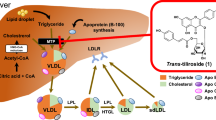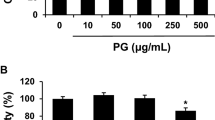Abstract
The purpose of the present study was to examine the role of tangeretin, a polymethoxylated flavone from citrus fruits, on the regulation of apolipoprotein B (apoB) and lipid metabolism in the human hepatoma cell-line HepG2. The marked reduction in apoB secretion observed in cells incubated with 72.8 μM tangeretin was rapid, apoB-specific, and partly reversible. The reduction also was observed under lipid-rich conditions and found to be insensitive to proteasomal degradation of nascent apoB. We followed our study by examining lipid synthesis and mass. A 24-h exposure of cells to 72.8 μM tangeretin decreased intracellular synthesis of cholesteryl esters, free cholesterol, and TAG by 82, 45, and 64%, respectively; tangeretin also reduced the mass of cellular TAG by 37%. The tangeretin-induced suppression of TAG synthesis and mass were associated with decreased activities of DAG acyltransferase (up to-39.0±3.0% vs. control) and microsomal triglyceride transfer protein (up to−35.5±2.5% vs. control). Tangeretin was also found to activate the peroxisome proliferator-activated receptor, a transcription factor with a positive regulatory impact on FA oxidation and TAG availability (up to 36% increase vs. control). The data suggest that tangeretin modulates apoB-containing lipoprotein metabolism through multiple mechanisms.
Similar content being viewed by others
Abbreviations
- ACAT:
-
aeyl CoA:cholesterol acyltransferase
- apo B:
-
apolipoprotein B
- apoB-Lp:
-
apoB-containing lipoprotein
- CE:
-
cholesteryl esters
- DGAT:
-
diacylglycerol acyltransferase
- EMSA:
-
electrophoretic mobility shift assay
- ER:
-
endoplasmic reticulum
- HMGR:
-
3-hydroxy-3-methylglutaryl-CoA reductase
- MG-132:
-
carbobenzoxy-l-leucyl-l-leucyl-l-leucinal
- MTP:
-
microsomal triglyceride transfer protein
- MTT:
-
3-(4,5-dimethylthiazol-2-yl)-2,5-diphenyltetrazolium bromide
- PMF:
-
polymethoxyflavone(s)
- PPAR:
-
peroxisome proliferator-activated receptor
References
Hollman, P.C., Hertog, M.G., and Katan, M.B. (1996) Role of Dietary Flavonoids in Protection Against Cancer and Coronary Heart Disease, Biochem. Soc. Trans. 24, 785–789.
Cook, N.C., and Samman, S. (1996) Flavonoids, Chemistry, Metabolism, Cardioprotective Effects, and Dietary Sources, J. Nutr. Biochem. 7, 66–76.
Kurowska, E.M., and Manthey, J.A. (2002) Regulation of Lipoprotein Metabolism in HepG2 Cells by Citrus Flavonoids, Adv. Exp. Med. Biol. 505, 173–179.
Horowitz, R.M., and Gentili, B. (1977) Flavonoid Constituents of Citrus, in Citrus Science and Technology (Nagy, S., Shaw, P.E., and Veldhuis, M.K., eds.), Vol. 1, pp. 397–426, AVI Publishing, Westport, CT.
Dixon, J.L., and Ginsberg, H.N. (1993) Regulation of Hepatic Secretion of Apolipoprotein B-Containing Lipoproteins: Information Obtained from Cultured Liver Cells, J. Lipid Res. 34, 167–179.
Borradaile, N.M., Carroll, K.K., and Kurowska, E.M. (1999) Regulation of ApoB Metabolism in HepG2 Cells by the Citrus Flavanones Hesperetin and Naringenin, Lipids 34, 591–598.
Wilcox, L.J., Borradaile, N.M., de Dreu, L.E., and Huff, M.W. (2001) Secretion of Hepatocyte ApoB Is Inhibited by the Flavonoids, Naringenin and Hesperetin, via Reduced Activity and Expression of ACAT2 and MTP, J. Lipid Res. 42, 725–734.
Borradaile, N.M., de Dreu, L.E., Barrett, P.H., and Huff, M.W. (2002) Inhibition of Hepatocyte ApoB Secretion by Naringenin: Enhanced Rapid Intracellular Degradation Independent of Reduced Microsomal Cholesteryl Esters, J. Lipid Res. 43, 1544–1554.
Borradaile, N.M., de Dreu, L.E., Barrett, P.H., Behrsin, C.D., and Huff, M.W. (2003) Hepatocyte ApoB-Containing Lipoprotein Secretion Is Decreased by the Grapefruit Flavonoid, Naringenin, via Inhibition of MTP-Mediated Microsomal Triglyceride Accumulation, Biochemistry 11, 1283–1291.
Wang, Y., Tran, K., and Yao, Z. (1999) The Activity of Microsomal Triglyceride Transfer Protein Is Essential for Accumulation of Triglyceride Within Microsomes in McA-RH7777 Cells. A Unified Model for the Assembly of Very Low density Lipoproteins, J. Biol. Chem. 274, 27793–27800.
Bok, S.H., Lee, S.H., Park, Y.B., Bae, K.H., Son, K.H., Jeong, T.S., and Choi, M.S. (1999) Plasma and Hepatic Cholesterol and Hepatic Activities of 3-Hydroxy-3-Methyl-Glutaryl-CoA Reductase and Acyl CoA:Cholesterol Transferase Are Lower in Rats Fed Citrus Peel Extract or a Mixture of Citrus Bioflavonoids, J. Nutr. 129, 1182–1185.
Chiba, H., Uehara, M., Wu, J., Wang, X., Masuyama, R., Suzuki, K., Kanazawa, K., and Ishimi, Y. (2003) Hesperidin, a Citrus Flavonoid, Inhibits Bone Loss and Decreases Serum and Hepatic Lipids in Ovariectomized Mice, J. Nutr. 133, 1892–1897.
Kurowska, E.M., Borradaile, N.M., Spence, J.D., and Carroll, K.K. (2000) Hypocholesterolemic Effects of Dietary Citrus Juices in Rabbits, Nutr. Res. 20, 121–129.
Manthey, J.A., Guthrie, N., and Grohmann, K. (2001) Biological Properties of Citrus Flavonoids Pertaining to Cancer and Inflammation, Curr. Med. Chem. 8, 135–153.
Nielsen, S.E., Breinholt, V., Cornett, C., and Dragsted, L.O. (2000) Biotransformation of the Citrus Flavone Tangeretin in Rats. Identification of Metabolites with Intact Flavane Nucleus, Food Chem. Toxicol. 38, 739–746.
Borradaile, N.M., de Dreu, L.E., Wilcox, L.J., Edwards, J.Y., and Huff, M.W. (2002) Soya Phytoestrogens, Genistein and Daidzein, Decrease Apolipoprotein B Secretion from HepG2 Cells Through Multiple Mechanisms, Biochem. J. 366, 531–539.
Theriault, A., Wang, Q., Van Iderstine, S.C., Chen, B., Franke, A.A., and Adeli, K. (2000) Modulation of Hepatic Lipoprotein Synthesis and Secretion by Taxifolin, a Plant Flavonoic, J. Lipid Res. 41, 1969–1979.
Casaschi, A., Wang, Q., Dang, K., Richards, A., and Theriault, A. (2002) Intestinal Apolipoprotein B Secretion Is Inhibited by the Flavonoid Quercetin: Potential Role of Microsomal Triglyceride Transfer Protein and Diacylglycerol Acyltransferase, Lipids 37, 647–652.
Berge, R.K., Madsen, L., Vaagenes, H., Tronstad, K.J., Gottlicher, M., and Rustan, A.C. (1999) In Contrast with Docosahexaenoic Acid, Eicosapentaenoic Acid and Hypolipidaemic Derivatives Decrease Hepatic Synthesis and Secretion of Triacylglycerol by Decreased Diacylglycerol Acyltransferase Activity and Stimulation of Fatty Acid Oxidation, Biochem. J. 343, 191–197.
Takahashi, N., Kawada, T., Goto, T., Yamamoto, T., Taimatsu, A., Matsui, N., Kimura, K., Saito, M., Hosokawa, M., Miyashita, K., and Fushiki, T. (2002) Dual Action of Isopernols from Herbal Medicines on Both PPARγ and PPARα in 3T3-L1 Adipocytes and HepG2 Hepatocytes, FEBS Lett. 514, 315–322.
Keller, J.M., Collet, P., Bianchi, A., Huin, C., Bouillaud-Kremarik, P., Becuwe, P., Schohn, H., Domenjoud, L., and Dauca, M. (2000) Implications of Peroxisome Proliferator-Activated Receptors (PPARs) in Development, Cell Life Status and Disease, Int. J. Dev. Biol. 44, 429–442.
Middleton, E., Jr., Drzewiecki, G., and Tatum, J. (1987) The Effects of Citrus Flavonoids on Human Basophil and Neutrophil Function, Planta. Med. 53, 325–328.
Kurowska, E.M. (2001) Determination of Cholesterol-Lowering Potential of Minor Dietary Components by Measuring Apolipoprotein B Responses in HepG2 Cells, in Methods in Enzymology, Flavonoids and Polyphenols (Packer, L., ed.), Vol. 335, pp. 398–404, Academic Press, San Diego, CA.
Musanti, R., Giorgini, L., Lovisoli, O., Pirillo, A., Chiari, A., and Ghiselli, G. (1996) Inhibition of Acyl-CoA:Cholesterol Acyltransferase Decreases Apolipoprotein B-100-Containing Lipoprotein from HepG2 Cells, J. Lipid Res. 37, 1–14.
Carr, T.P., Andersen, C.J., and Rudel, L.L. (1993) Enzymatic Determination of Triglyceride, Free Cholesterol, and Total Cholesterol in Tissue Lipid Extracts, Clin. Biochem. 26, 39–42.
Zhang, Z., Sniderman, A.D., Kalant, D., Vu, H., Monge, J.C., Tao, Y., and Cianflone, K. (1993) The Role of Amino Acids in ApoB100 Synthesis and Catabolism in Human HepG2 Cells, J. Biol. Chem. 268, 26920–26926.
Grigor, M.R., and Bell, R.M. (1962) Separate Monoacylglycerol and Diacylglycerol Acyltransferases Function in Intestinal Triacylglycerol Synthesis, Biochim. Biophys. Acta 712, 464–472.
Dignam, J.D., Lebovitz, R.M., and Roeder, R.G. (1983) Accurate Transcription Initiation by RNA Polymerase II in a Soluble Extract from Isolated Mammalian Nuclei, Nucleic Acids Res. 11, 1475–1489.
Kurowska, E.M., and Carroll, K.K. (1998) Hypocholesterolemic Properties of Nitric Oxide. In vivo and In vitro Studies Using Nitric Oxide Donors, Biochim. Biophys. Acta 1392, 41–50.
Hansen, M.B., Nielsen, S.E., and Berg, K. (1989) Re-examination and Further Development of a Precise and Rapid Dye Method for Measuring Cell Growth/Cell Kill, J. Immunol. Methods 119, 203–210.
Sakata, N., Wu, X., Dixon, J.L., and Ginsberg, H.N. (1993) Proteolysis and Lipid-Facilitated Translocation Are Distinct but Competitive Processes That Regulate Secretion of Apolipoprotein B in HepG2 Cells, J. Biol. Chem. 268, 22967–22970.
Arrol, S., Mackness, M.I., and Durrington, P.N. (2000) The Effects of Fatty Acids on Apolipoprotein B Secretion by Human Hepatoma Cells (HepG2), Atherosclerosis 150, 255–264.
Kraft, H.G., Demosky, S.J., Jr., Schumacher, K., Brewer, H.B., Jr., and Hoeg, J.M. (1992) Regulation of LDL Receptor, ApoB, and ApoE Protein and mRNA in HepG2 cells, DNA Cell Biol. 11, 291–300.
Senafi, S.B., Clarke, D.J., and Burchell, B. (1994) Investigation of the Substrate Specificity of a Cloned Expressed Human Bilirubin UDP-Glucuronosyltransferase: UDP-Sugar Specificity and Involvement in Steroid and Xenobiotic Glucuronidation, Biochem. J. 303, 233–240.
O'Leary, K.A., Day, A.J., Needs, P.W., Mellon, F.A., O'Brien, N.M., and Williamson, G. (2003) Metabolism of Quercetin-7-and Quercetin-3-glucuronides by an in vitro Hepatic Model: The Role of Human β-Glucuronidase, Sulfotransferase, Catechol-O-methyltransferase and Multi-resistant Protein 2 (MRP2) in Flavonoid Metabolism, Biochem. Pharmacol. 65, 479–491.
Galijatovic, A., Otake, Y., Walle, K., and Walle, T. (1999) Extensive Metabolism of the Flavonoid Chrysin by Human Caco-2 and HepG2 Cells, Xenobiotica 29, 1241–1256.
Davis, R.A. (1999) Cell and Molecular Biology of the Assembly and Secretion of Apolipoprotein B-Containing Lipoproteins by the Liver, Biochim. Biophys. Acta 1440, 1–31.
Hussain, M.M., Shi, J., and Dreizen, P. (2003) Microsomal Triglyceride Transfer Protein and Its Role in ApoB-Lipoprotein Assembly, J. Lipid Res. 44, 22–32.
Wu, X., Shang, A., Jiang, H., and Ginsberg, H.N. (1996) Low Rates of ApoB Secretion fromHepG2 Cells Result from Reduced Delivery of Newly Synthesized Triglyceride to a “Secretion-Coupled” Pool, J. Lipid Res. 37, 1198–1206.
Cases, S., Smith, S.J., Zheng, Y.W., Myers, H.M., Lear, S.R., Sande, E., Novak, S., Collins, C., Welch, C.B., Lusis, A.J., Erickson, S.K., and Farese, R.V., Jr. (1998) Identification of a Gene Encoding an Acyl CoA:Diacylglycerol Acyltransferase, a Key Enzyme in Triacylglycerol Synthesis, Proc. Natl. Acad. Sci. USA 27, 13018–13023.
Fruchart, J.C., Staels, B., and Duriez, P. (2001) PPARs, Metabolic Disease and Atherosclerosis, Pharmacol. Res. 44, 345–352.
Berger, J., and Moller, D.E. (2002) The Mechanisms of Action of PPARs, Annu. Rev. Med. 53, 409–435.
Author information
Authors and Affiliations
Corresponding author
About this article
Cite this article
Kurowska, E.M., Manthey, J.A., Casaschi, A. et al. Modulation of hepG2 cell net apolipoprotein B secretion by the citrus polymethoxyflavone, tangeretin. Lipids 39, 143–151 (2004). https://doi.org/10.1007/s11745-004-1212-8
Received:
Revised:
Accepted:
Issue Date:
DOI: https://doi.org/10.1007/s11745-004-1212-8




